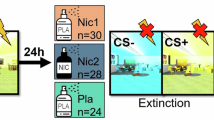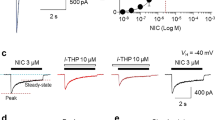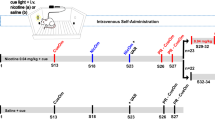Abstract
The primary reinforcing effects of nicotine are mediated by the drugs action at central nervous system nicotinic acetylcholine receptors (nAChRs). Although previous studies have demonstrated that nicotine potently enhances responding for non-pharmacological stimuli, the role of nAChRs in this reinforcement-enhancing effect is not known. The two reinforcement-related effects of nicotine can be dissociated in a paradigm that provides concurrent access to drug infusions and a non-pharmacological visual stimulus (VS). The present study characterized the role of nAChRs in the primary reinforcing effect of nicotine and the reinforcement-enhancing effect of nicotine. For rats with access to VS (VS-Only), nicotine (NIC-Only), both reinforcers contingent upon one response (NIC+VS) or both reinforcers contingent upon separate responses (2-Lever), unit dose–response relationships (0, 30, 60, or 90 μg/kg/infusion, free base) were determined over a 22-day acquisition period. Expression of the two reinforcement-related effects of nicotine was manipulated by pharmacological antagonism of nAChRs (1 mg/kg mecamylamine, subcutaneous, 5-min before the session) or by substituting saline for nicotine infusions (ie extinction) over a series of seven test sessions. Unit dose manipulations yielded an inverse dose–response relationship for active lever responding in the NIC+VS group. The dose–response relationships for rats with independent access to each reinforcer (2-Lever group) were relatively flat. For the 2-Lever group, acute mecamylamine challenge blocked the reinforcement-enhancing effects of nicotine, VS-lever responding decreased to basal levels on the first day of mecamylamine treatment or saline substitution (to the level of the VS-Only group). In contrast, nicotine-lever responding decreased gradually over the 7-day testing period (similar to saline extinction). The two reinforcement-related effects of nicotine are mediated by nAChRs but can be dissociated by acute and chronic profiles.
Similar content being viewed by others
Log in or create a free account to read this content
Gain free access to this article, as well as selected content from this journal and more on nature.com
or
References
Balfour DJ, Wright AE, Benwell ME, Birrell CE (2000). The putative role of extra-synaptic mesolimbic dopamine in the neurobiology of nicotine dependence. Behav Brain Res 113: 73–83.
Bevins RA, Palmatier MI (2003). Effects of nicotine preexposure on the conditioned and unconditioned psychomotor effects of nicotine in rats. Behav Brain Res 143: 65–74.
Caggiula AR, Donny EC, White AR, Chaudhri N, Booth S, Gharib MA et al (2002). Environmental stimuli promote the acquisition of nicotine self-administration in rats. Psychopharmacology 163: 230–237.
Chaudhri N, Caggiula AR, Donny EC, Booth S, Gharib M, Craven L et al (2006b). Self-administered and noncontingent nicotine enhance reinforced operant responding in rats: impact of nicotine dose and reinforcement schedule. Psychopharmacology, doi:10.1007/s00213-006-0522-0.
Chaudhri N, Caggiula AR, Donny EC, Booth S, Gharib M, Craven L et al (2006c). Dissociating the dual-actions of nicotine: primary reinforcement and the reinforcement-enhancing actions of nicotine impact operant responding for a visual stimulus in rats. Psychopharmacology, doi:10.1007/s00213-006-0454-8.
Chaudhri N, Caggiula AR, Donny EC, Palmatier MI, Liu X, Sved AF (2006a). Complex interactions between nicotine and nonpharmacological stimuli reveal multiple roles for nicotine in reinforcement. Psychopharmacology 184: 353–366.
Corrigall WA, Coen KM (1989). Nicotine maintains robust self-administration in rats on a limited-access schedule. Psychopharmacology 99: 473–478.
Corrigall WA, Coen KM (1994). Nicotine self-administration and locomotor activity are not modified by the 5-HT3 antagonists ICS 205-930 and MDL 72222. Pharmacol Biochem Behav 49: 67–71.
Corrigall WA, Coen KM, Adamson KL (1994). Self-administered nicotine activates the mesolimbic dopamine system through the ventral tegmental area. Brain Res 653: 278–284.
Di Chiara G (2000). Role of dopamine in the behavioural actions of nicotine related to addiction. Eur J Pharmacol 393: 295–314.
Donny EC, Caggiula AR, Knopf S, Brown C (1995). Nicotine self-administration in rats. Psychopharmacology 122: 390–394.
Donny EC, Caggiula AR, Mielke MM, Jacobs KS, Rose C, Sved AF (1998). Acquisition of nicotine self-administration in rats: the effects of dose, feeding schedule, and drug contingency. Psychopharmacology 136: 83–90.
Donny EC, Caggiula AR, Mielke MM, Booth S, Gharib MA, Hoffman A et al (1999). Nicotine self-administration in rats on a progressive ratio schedule of reinforcement. Psychopharmacology 147: 135–142.
Donny EC, Chaudhri N, Caggiula AR, Evans-Martin FF, Booth S, Gharib MA et al (2003). Operant responding for a visual reinforcer in rats is enhanced by noncontingent nicotine: implications for nicotine self-administration and reinforcement. Psychopharmacology 169: 68–76.
Goldberg SR, Spealman RD, Goldberg DM (1981). Persistent behavior at high rates maintained by intravenous self-administration of nicotine. Science 214: 573–575.
Gonon FG (1988). Nonlinear relationship between impulse flow and dopamine released by rat midbrain dopaminergic neurons as studied by in vivo electrochemistry. Neuroscience 24: 19–28.
Harvey DM, Yasar S, Heishman SJ, Panlilio LV, Henningfield JE, Goldberg SR (2004). Nicotine serves as an effective reinforcer of intravenous drug-taking behavior in human cigarette smokers. Psychopharmacology 175: 134–142.
Jaffe JH (1990). Trivializing dependence. Br J Addict 85: 1425–1427.
Laviolette SR, van der Kooy D (2003). The motivational valence of nicotine in the rat ventral tegmental area is switched from rewarding to aversive following blockade of the alpha7-subunit-containing nicotinic acetylcholine receptor. Psychopharmacology 166: 306–313.
Laviolette SR, van der Kooy D (2004). The neurobiology of nicotine addiction: bridging the gap from molecules to behaviour. Nat Rev Neurosci 5: 55–65.
Liu X, Caggiula AR, Palmatier MI, Donny EC, Chaudhri N, Sved AF (2005). Reinforcement Enhancing Effect of Nicotine Depends on the Reinforcement Valence of Non-drug Stimulus, Program No. 1027.14. Society for Neuroscience: Washington, DC.
Mansbach RS, Chambers LK, Rovetti CC (2000). Effects of the competitive nicotinic antagonist erysodine on behavior occasioned or maintained by nicotine: comparison with mecamylamine. Psychopharmacology 148: 234–242.
Mansvelder HD, Keath JR, McGehee DS (2002). Synaptic mechanisms underlie nicotine-induced excitability of brain reward areas. Neuron 33: 905–919.
Olausson P, Jentsch JD, Taylor JR (2003). Repeated nicotine exposure enhances reward-related learning in the rat. Neuropsychopharmacology 28: 1264–1271.
Olausson P, Jentsch JD, Taylor JR (2004). Repeated nicotine exposure enhances responding with conditioned reinforcement. Psychopharmacology 173: 98–104.
Palmatier MI, Caggiula AR, Liu X, Chaudhri N, Donny EC, Booth S et al (2006). Dissociating the primary reinforcing and reinforcement enhancing effects of nicotine in self-administration with concurrently available drug and environmental reinforcers. Psychopharmacology 184: 391–400.
Picciotto MR, Corrigall WA (2002). Neuronal systems underlying behaviors related to nicotine addiction: neural circuits and molecular genetics. J Neurosci 22: 3338–3341.
Risner ME, Goldberg SR (1983). A comparison of nicotine and cocaine self-administration in the dog: fixed-ratio and progressive-ratio schedules of intravenous drug infusion. J Pharmacol Exp Ther 224: 319–326.
Rose JE (2006). Nicotine and nonnicotine factors in cigarette addiction. Psychopharmacology 184: 274–285.
Rose JE, Behm FM, Westman EC, Bates JE, Salley A (2003). Pharmacologic and sensorimotor components to satiation in cigarette smoking. Pharmacol Biochem Behav 76: 243–250.
Rose JE, Behm FM, Westman EC, Johnson M (2000). Dissociating nicotine and nonnicotine components of cigarette smoking. Pharmacol Biochem Behav 67: 71–81.
Rose JE, Levin ED (1991). Inter-relationships between conditioned and primary reinforcement in the maintenance of cigarette smoking. Br J Addict 86: 605–609.
Schilström B, Rawal N, Mameli-Engvall M, Nomikos GG, Svensson TH (2003). Dual effects of nicotine on dopamine neurons mediated by different nicotine receptor subtypes. Int J Neuropsychopharm 6: 1–11.
Shoaib M, Schindler CW, Goldberg SR (1997). Nicotine self-administration in rats: strain and nicotine pre-exposure effects on acquisition. Psychopharmacology 129: 35–43.
USDHHS (1988). Nicotine addiction: a report of the surgeon general. US Department of Health and Human Services, Office of the Assistant Secretary for Health, Office on Smoking and Health, Rockville, MD.
Wise RA (1987). Intravenous drug self-administration: a special case of positive reinforcement. In: Bozarth MA (ed). Methods of Assessing the Reinforcing Properties of Abused Drugs. Springer-Verlag: New York. pp 117–141.
Acknowledgements
We thank Sheri Booth, Maysa Gharib, Laure Craven, Prema Chaudhri, and Jessica Black for their assistance conducting the studies. All experiments followed the ‘Principles of laboratory animal care’ (NIH #85-23, revised 1985) and were approved by the University of Pittsburgh Institutional Animal Care and Use Committee (Assurance # A3187-01). This research was supported by NIH Grants DA-10464, DA-12655, and DA-19278.
Author information
Authors and Affiliations
Corresponding author
Rights and permissions
About this article
Cite this article
Palmatier, M., Liu, X., Caggiula, A. et al. The Role of Nicotinic Acetylcholine Receptors in the Primary Reinforcing and Reinforcement-Enhancing Effects of Nicotine. Neuropsychopharmacol 32, 1098–1108 (2007). https://doi.org/10.1038/sj.npp.1301228
Received:
Revised:
Accepted:
Published:
Issue date:
DOI: https://doi.org/10.1038/sj.npp.1301228
Keywords
This article is cited by
-
Elucidating the reinforcing effects of nicotine: a tribute to Nadia Chaudhri
Psychopharmacology (2023)
-
Differentiating the primary reinforcing and reinforcement-enhancing effects of varenicline
Psychopharmacology (2015)
-
Prior Exposure to THC Increases the Addictive Effects of Nicotine in Rats
Neuropsychopharmacology (2013)
-
Nicotine-, tobacco particulate matter- and methamphetamine-produced locomotor sensitisation in rats
Psychopharmacology (2013)
-
The effect of nicotine on sign-tracking and goal-tracking in a Pavlovian conditioned approach paradigm in rats
Psychopharmacology (2013)



